 |  |
By Shari Bondy
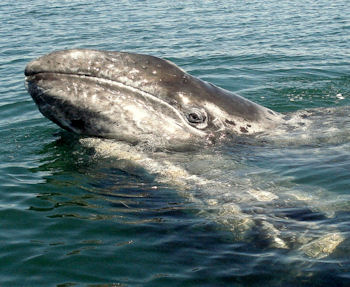
Gazing into the eye of a whale is a humbling, life changing encounter you will never forget. Whale watching is a delicate art and can be a very moving experience. When an enormous whale glides over to your small panga...the sheer size, beauty & grace is awe inspiring indeed. It is really indescribable what happens when you share inter-species contact with this magnificent mammal.
Ojo de Liebre, the largest calving lagoon in the world, usually has over 1,500 whales in mid season so you are literally surrounded by whales at all times. It is a privilege to be able to observe the gray whales in their natural habitat...the nursery where the mothers bear & raise their calves. Every trip is different and unique depending on the tide, weather, lanchero, time of day, the whale’s moods and activities and who is in the panga with you. One trip may experience a wide variety of whale behavior like breaching, spy hopping, mating, playing and if you are lucky, physical & eye contact…and the next boat out may only see whales sleeping!
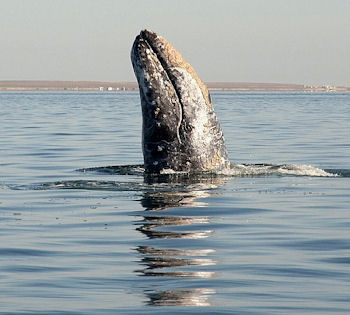
A friendly whale will swim over to or around the boat to “read” the situation then decide to approach closer or not. They often pass under the panga or glide sideways looking up at you. They can perceive if someone is afraid and may keep a respectful distance so as not to frighten anyone, but if everyone welcomes a visit, the whale may raise up it's mighty head to meet your touch. Often a mother whale will push her calf up to see the boat especially if there are young children on board. Later in the season, when the calves are older, they seem to enjoy visiting the people in the pangas much of their day passing on from one person to the next so all can get a good look at the curious baby.
All visitors must treat the whales with respect and caution. It is a privilege to be able to be in their nursery while they are busy raising their calves. A whale that becomes irritated, jealous or overly playful can be aggressive so listen to the guide if you are warned to sit down or to keep your hands inside the boat. Never try to touch a whale's tail or pectoral fins, as an exuberant calf could inadvertantly injure you.
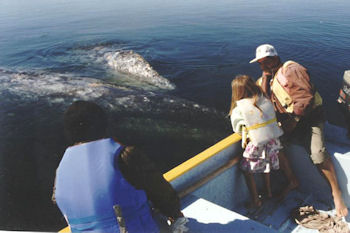
BIRTH OF A DESERT WHALE
Laguna Ojo de Liebre, a Unesco World Heritage Site, is part of the Vizcaino Biosphere Reserve, Latin America’s biggest reserve,. It is a critical habitat for gray whale reproduction as well as for four species of endangered marine turtles and important refuge for waterfowl in the winter. Ojo de Liebre was named after a fresh water spring nearby but is widely known north of the border as Scammon’s Lagoon named after Charles Scammon who first entered the lagoon in December 1857 in the brig Boston to hunt the gray whales breeding there.
The lagoon near Guerrero Negro in central Baja California is 9 km wide, 48 km long and from 5 to 12 meters deep. Relatively deep channels cut through the lagoon between its broad intertidal flats. The climate is dry and warm; the annual temperature ranges from 18° C and 22° C. Some years almost a thousand calves are born there and they spend 3 months nursing while gaining strength to make the long migration north. Gray whales undertake the longest migration of any marine mammal (16,000 km round trip) in order to give birth to their calves in the warm, protected lagoons of Baja California Sur where the desert meets the sea. The birthing takes place soon after they arrive and often attended by another whale...a midwife perhaps?
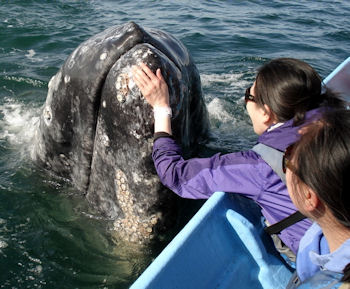
The picture above was taken early in January when 2 adult whales (one very pregnant) were hanging out with the whale watching panga. They stayed with the boat for a long time taking turns getting their noses rubbed. It felt like they were just biding their time until the baby was born. Most mating also happens in January which is a raucous event with lots of intense splashing of tails and flippers. There are often three whales involved and sometimes more floating in the wings waiting for a chance.
Gray whales are born tail first then float up to the surface of the salty baja lagoons. If they don't take their first breath immediately, the mother will gently smack the newborn with her tail or flippers to get it breathing. The calves are born pinkish gray and their skin darkens when exposed to the water and air. They have the cutest dimples on their short snub noses with hairs growing out of them and are the size of a small car, weighing in at about a ton when they are born. They nurse almost constantly the first week gaining up to sixty pounds a day on their mother's rich milk which is about 53% fat (human milk is 2%). To make it easier for the calf to nurse, mom will roll over on her side with her pectoral fin in the air for balance exposing her mammary slit so the calf can nuzzle up and catch the thick milk that is shot out in a stream. In their first month, the babies tire easily and often climb on their mother's back to catch a free ride...or they will place their chin or flukes across her back to rest. They stick very close to their mother and she is extremely protective of her baby during the first few weeks in the lagoon.
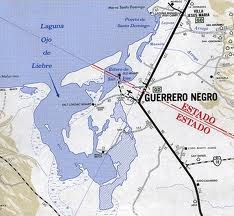
When whale watching first began in the lagoons, the mother’s would usually switch the calves over to the other side when a boat approached to protect them but now they trust the pangas and will even take a nap when a boat is near leaving us to babysit her calf while she sleeps! Baby Gray Whales are an amazing animal to watch in the wild and January is the best time to witness births and see the newborns. Mother whales teach their babies about boats and often bring the calf up and push it into the motor to show them it is sharp. Many times the mothers bring their calves over to show them what human kids look like. Having a whale reach up to meet your touch is nothing like you have ever experienced before. You will never EVER forget it!
About Shari Bondy
Your Guide: Shari Bondy has been guiding at the lagoon since 1988...before commercial whale watching began and helped institute the whale protection regulations and train the lancheros how to approach whales safely and respectfully. She lived in Guerrero Negro for 10 years so is very familiar with the city and where to go and what to see. She has developed a personal relationship with the staff at Ojo de Liebre and knows her whales.
She now lives a couple hours south of there in Bahia Asuncion where she & her husband operate a bilingual tourism business with a hotel, La Bufadora Inn, vacation rental houses, campground, diving, nature tours, snorkeling with sea lion & sport fishing charters. For more information visit the Bahia Ascunción website and Whale Magic Tours website.